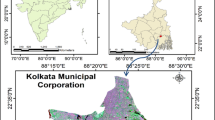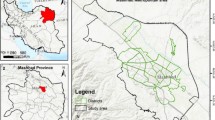Abstract
Change in land surface temperature (LST) due to urbanization is a critical influence on the ecohydrological function and human health in cities. Past research has emphasized land cover composition and planimetric landscape pattern as drivers of LST patterns, but there have been few empirical studies examining the effects of vertical structure on thermal variation in cities. We used agglomerative cluster analysis to group 5 ha grid cells with similar land cover composition from high-resolution land cover data for our Aurora, Colorado, USA study area. We then compared the importance of different planimetric landscape pattern metrics and lidar-derived vertical structure variables as predictors of LST estimated from Landsat 5 thermal band data for each group. Variation in LST between cluster groups was analyzed with landscape and vertical structure data using random forest regression models and conditional variable importance metrics. Cluster analysis produced 7 distinct groups differing in land cover composition, planimetric landscape pattern, and vertical structure. Clusters with greater tree cover and higher mean tree height were generally cooler, while the height difference between buildings and trees had high conditional variable importance in random forest regression models. We found that the specific planimetric landscape pattern and vertical structure metrics most important for individual clusters differed, suggesting that the relative importance of variables depends on land-use and land cover. Our results highlight the importance of including vertical structure in empirical analyses of urban LST.









Similar content being viewed by others
References
Arnfield AJ (2003) Two decades of urban climate research: a review of turbulence, exchanges of energy and water, and the urban heat island. Int J Climatol 23:1–26
Breiman L (2001) Random forests. machine learning 45:5–32
Connors JP, Galletti CS, Chow WTL (2013) Landscape configuration and urban heat island effects: assessing the relationship between landscape characteristics and land surface temperature in Phoenix, Arizona Landscape Ecol 28:271–283. doi: 10.1007/s10980-012-9833-1
Cushman SA, McGariyal K, Neel MC (2008) Parsimony in landscape metrics: strength, universality, and consistency. Ecol Indic 8:691–703. doi:10.1016/j.ecolind.2007.12.002
Day WH, Edelsbrunner H (1984) Efficient algorithms for agglomerative hierarchical clustering methods. J Classif 1:7–24
Declet-Barreto J, Brazel A, Martin C, Chow WL, Harlan S (2013) Creating the park cool island in an inner-city neighborhood: heat mitigation strategy for Phoenix. AZ Urban Ecosyst 16:617–635. doi:10.1007/s11252-012-0278-8
Diaz-Uriarte R, Alvarez de Andres S (2006) Gene selection and classification of microarray data using random forest. BMC Bioinformatics 7:3. doi:10.1186/1471-2105-7-3
Dormann CF et al (2013) Collinearity: a review of methods to deal with it and a simulation study evaluating their performance. Ecography 36:27–46. doi:10.1111/j.1600-0587.2012.07348.x
Emmanuel R, Fernando H (2007) Urban heat islands in humid and arid climates: role of urban form and thermal properties in Colombo, Sri Lanka and Phoenix, USA. Clim Res 34:241
Gage EA (2014) A multi-scale analysis of vegetation and irrigation heterogenity effects on ecohydrological function and ecosystem services in a semi-arid urban area. Dissertation, Colorado State University
Gallo KP, McNab AL, Karl TR, Brown JF, Hood JJ, Tarpley JD (1993) The use of a vegetation index for assessment of the urban heat island effect. Int J Remote Sens 14:2223–2230. doi:10.1080/01431169308954031
Georgescu M, Moustaoui M, Mahalov A, Dudhia J (2011) An alternative explanation of the semiarid urban area “oasis effect”. Journal of Geophysical Research: Atmospheres 116:D24113 doi: 10.1029/2011JD016720
Gober P, Middel A, Brazel A, Myint S, Chang H, Duh JD, House-Peters L (2012) Tradeoffs between water conservation and temperature amelioration in phoenix and portland: implications for urban sustainability. Urban Geogr 33:1030–1054. doi:10.2747/0272-3638.33.7.1030
Grimm NB, Faeth SH, Golubiewski NE, Redman CL, Wu JG, Bai XM, Briggs JM (2008) Global change and the ecology of cities. Science 319:756–760. doi:10.1126/science.1150195
Grimmond C, Oke T (1999) Evapotranspiration rates in urban areas. Paper presented at the impacts of urban growth on surface water and groundwater quality, proceedings of lOGO 99 symposium, Birmingham, UK
Grimmond CSB (1992) The suburban energy-balance - methodological considerations and results for a midlatitude west-coast city under winter and spring conditions. Int J Climatol 12:481–497
Guhathakurta S, Gober P (2007) The impact of the Phoenix urban heat island on residential water use. J Am Plan Assoc 73:317–329
Halper EB, Scott CA, Yool SR (2012) Correlating vegetation, water use, and surface temperature in a semiarid city: a multiscale analysis of the impacts of irrigation by single-family residences. Geogr Analysis 44:235–257. doi:10.1111/j.1538-4632.2012.00846.x
Hapfelmeier A, Ulm K (2013) A new variable selection approach using random forests. Comput Stat Data Anal 60:50–69. doi:10.1016/j.csda.2012.09.020
Hu X, Zhou W, Qian Y, Yu W (2016) Urban expansion and local land-cover change both significantly contribute to urban warming, but their relative importance changes over time. Landsc Ecol:1–18. doi:10.1007/s10980-016-0484-5
Huang G, Cadenasso ML (2016) People, landscape, and urban heat island: dynamics among neighborhood social conditions, land cover and surface temperatures. Landsc Ecol:1–9. doi:10.1007/s10980-016-0437-z
Jackson RB et al (2008) Protecting climate with forests Environmental Research Letters 3:044006. doi:10.1088/1748-9326/3/4/044006
Jenerette GD et al (2015) Micro-scale urban surface temperatures are related to land-cover features and residential heat related health impacts in Phoenix, AZ USA. Landscape Ecol:1–16. doi:10.1007/s10980-015-0284-3
Kaufman L, Rousseeuw PJ (2005) Finding groups in data: an introduction to cluster analysis, vol 344. Wiley, Hoboken, NJ
Kuang W et al (2015) What are hot and what are not in an urban landscape: quantifying and explaining the land surface temperature pattern in Beijing, China. Landsc Ecol 30:357–373. doi:10.1007/s10980-014-0128-6
Li H, Wu J (2004) Use and misuse of landscape indices. Landsc Ecol 19:389–399
Liaw A, Wiener M (2002) Classification and regression by randomForest. R News 2:18–22
Lin CY, Chen F, Huang JC, Chen WC, Liou YA, Chen WN, Liu SC (2008) Urban heat island effect and its impact on boundary layer development and land-sea circulation over northern Taiwan. Atmos Environ 42:5635–5649. doi:10.1016/j.atmosenv.2008.03.015
Luber G, McGeehin M (2008) Climate change and extreme heat events. Am J Prev Med 35:429–435. doi:10.1016/j.amepre.2008.08.021
Maimaitiyiming M et al (2014) Effects of green space spatial pattern on land surface temperature: implications for sustainable urban planning and climate change adaptation. ISPRS J Photogramm Remote Sens 89:59–66
Martin C, Stabler L (2002) Urban horticultural ecology: interactions between plants, people and the physical environment. In: ISHS Acta Horticulturae: XXVI international horticultural congress: expanding roles for horticulture in improving human well-being and life quality. ISHS, pp 97–101
Martin CA (2008) Landscape sustainability in a Sonoran desert city. Cities and the Environment (CATE) 1:5
Masek JG et al (2006) A Landsat surface reflectance dataset for North America, 1990–2000. IEEE Geosci Remote Sens Lett 3:68–72. doi:10.1109/LGRS.2005.857030
Masson V (2006) Urban surface modeling and the meso-scale impact of cities. Theor Appl Climatol 84:35–45
McCune B, Grace JB (eds) (2002) Analysis of ecological communities. Gleneden Beach, MjM Software Design
McDonnell M et al (1997) Ecosystem processes along an urban-to-rural gradient. Urban Ecosyst 1:21–36
McGarigal K, Marks M (1995) FRAGSTATS: spatial pattern analysis program for quantifying landscape structure. USDA Forest Service, Pacific Northwest Research Station
Middel A, Häb K, Brazel AJ, Martin CA, Guhathakurta S (2014) Impact of urban form and design on mid-afternoon microclimate in Phoenix local climate zones. Landsc Urban Plan 122:16–28
Myint SW et al (2015) Does the spatial arrangement of urban landscape matter? Examples of urban warming and cooling in Phoenix and Las Vegas. Ecosystem Health and Sustainability 1:1–15. doi: 10.1890/EHS14-0028.1
Oke TR (1982) The energetic basis of the urban heat island. Q J Royal Meteor Soc 108:1–24
Oke TR (1989) The micrometeorology of the urban forest. Philos Trans R Soc Lond Ser B Biol Sci 324:335–349
Owen TW, Carlson TN, Gillies RR (1998) An assessment of satellite remotely-sensed land cover parameters in quantitatively describing the climatic effect of urbanization. Int J Remote Sens 19:1663–1681
Patz JA, Campbell-Lendrum D, Holloway T, Foley JA (2005) Impact of regional climate change on human health. Nature 438:310–317
Peng J, Xie P, Liu Y, Ma J (2016) Urban thermal environment dynamics and associated landscape pattern factors: a case study in the Beijing metropolitan region. Remote Sens Environ 173:145–155. doi:10.1016/j.rse.2015.11.027
Phelan PE, Kaloush K, Miner M, Golden J, Phelan B, Silva H, Taylor RA (2015) Urban heat island: mechanisms, implications, and possible remedies Annual Review of Environment and Resources:40
Pielke R (2005) Land use and climate change. Science 310:1625–1626
Prasad A, Iverson L, Liaw A (2006) Newer classification and regression tree techniques: bagging and random forests for ecological prediction. Ecosystems 9:181–199. doi:10.1007/s10021-005-0054-1
R Core Team (2016) R: a language and environment for statistical computing version 3.31, 2.15 edn. R Foundation for Statistical Computing, Vienna
Rhee J, Park S, Lu Z (2014) Relationship between land cover patterns and surface temperature in urban areas. GIScience & Remote Sensing 51:521–536
Schindler S, Poirazidis K, Wrbka T (2008) Towards a core set of landscape metrics for biodiversity assessments: a case study from Dadia National Park, Greece. Ecol Indic 8:502–514
Shugart H, Saatchi S, Hall F (2010) Importance of structure and its measurement in quantifying function of forest ecosystems. J Geophys Res: Biogeosci 115:G00E13. doi: 10.1029/2009JG000993
Stabler LB, Martin CA, Brazel AJ (2005) Microclimates in a desert city were related to land use and vegetation index. Urban For Urban Green 3:137–147. doi:10.1016/j.ufug.2004.11.001
Strobl C, Boulesteix A-L, Zeileis A, Hothorn T (2007) Bias in random forest variable importance measures: illustrations, sources and a solution. BMC Bioinformatics 8:1–21. doi:10.1186/1471-2105-8-25
Strobl C, Malley J, Tutz G (2009) An introduction to recursive partitioning: rationale, application and characteristics of classification and regression trees, bagging and random forests. Psychol Methods 14:323–348. doi:10.1037/a0016973
Vierling KT, Vierling LA, Gould WA, Martinuzzi S, Clawges RM (2008) Lidar: shedding new light on habitat characterization and modeling. Front Ecol Environ 6:90–98. doi:10.1890/070001
Voogt JA, Oke TR (2003) Thermal remote sensing of urban climates. Remote Sens Environ 86:370–384. doi:10.1016/s0034-4257(03)00079-8
Walsh CJ, Roy AH, Feminella JW, Cottingham PD, Groffman PM, Morgan RP (2005) The urban stream syndrome: current knowledge and the search for a cure. J N Am Benthol Soc 24:706–723
Weng QH (2009) Thermal infrared remote sensing for urban climate and environmental studies: methods, applications, and trends. ISPRS J Photogramm Remote Sens 64:335–344. doi:10.1016/j.isprsjprs.2009.03.007
Weng QH, Lu DS, Schubring J (2004) Estimation of land surface temperature-vegetation abundance relationship for urban heat island studies. Remote Sens Environ 89:467–483. doi:10.1016/j.rse.2003.11.005
Xiao RB, Weng QH, Ouyang ZY, Li WF, Schienke EW, Zhang ZM (2008) Land surface temperature variation and major factors in Beijing, China. Photogramm Eng Remote Sensing 74:451–461
Yan WY, Shaker A, El-Ashmawy N (2015) Urban land cover classification using airborne LiDAR data: a review. Remote Sens Environ 158:295–310. doi:10.1016/j.rse.2014.11.001
Yuan F, Bauer ME (2007) Comparison of impervious surface area and normalized difference vegetation index as indicators of surface urban heat island effects in Landsat imagery. Remote Sens Environ 106:375–386. doi:10.1016/j.rse.2006.09.003
Yue W, Xu J, Tan W, Xu L (2007) The relationship between land surface temperature and NDVI with remote sensing: application to Shanghai Landsat 7 ETM+ data. Int J Remote Sens 28:3205–3226
Zhao L, Lee X, Smith RB, Oleson K (2014) Strong contributions of local background climate to urban heat islands. Nature 511:216–219
Zhou RW, Jiang WM, He XF, Liu G (2009) Study on effects of building morphology on urban boundary layer using an urban canopy model. Acta Meteorologica Sinica 23:338–349
Zhou W, Huang G, Cadenasso ML (2011) Does spatial configuration matter? Understanding the effects of land cover pattern on land surface temperature in urban landscapes. Landsc Urban Plan 102:54–63. doi:10.1016/j.landurbplan.2011.03.009
Acknowledgements
Support was provided by the City of Aurora Water Resources Division. Thanks to Andrea Borkenhagen, Erick Carlson and Jeremy Shaw for constructive comments on drafts of this manuscript.
Author information
Authors and Affiliations
Corresponding author
Rights and permissions
About this article
Cite this article
Gage, E.A., Cooper, D.J. Relationships between landscape pattern metrics, vertical structure and surface urban Heat Island formation in a Colorado suburb. Urban Ecosyst 20, 1229–1238 (2017). https://doi.org/10.1007/s11252-017-0675-0
Published:
Issue Date:
DOI: https://doi.org/10.1007/s11252-017-0675-0




